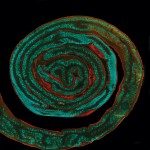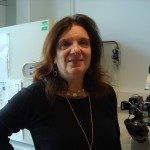Link to Pubmed [PMID] – 27528230
Oncotarget 2016 Aug;7(35):56083-56106
A mutation in the HERC2 gene has been linked to a severe neurodevelopmental disorder with similarities to the Angelman syndrome. This gene codifies a protein with ubiquitin ligase activity that regulates the activity of tumor protein p53 and is involved in important cellular processes such as DNA repair, cell cycle, cancer, and iron metabolism. Despite the critical role of HERC2 in these physiological and pathological processes, little is known about its relevance in vivo. Here, we described a mouse with targeted inactivation of the Herc2 gene. Homozygous mice were not viable. Distinct from other ubiquitin ligases that interact with p53, such as MDM2 or MDM4, p53 depletion did not rescue the lethality of homozygous mice. The HERC2 protein levels were reduced by approximately one-half in heterozygous mice. Consequently, HERC2 activities, including ubiquitin ligase and stimulation of p53 activity, were lower in heterozygous mice. A decrease in HERC2 activities was also observed in human skin fibroblasts from individuals with an Angelman-like syndrome that express an unstable mutant protein of HERC2. Behavioural analysis of heterozygous mice identified an impaired motor synchronization with normal neuromuscular function. This effect was not observed in p53 knockout mice, indicating that a mechanism independent of p53 activity is involved. Morphological analysis showed the presence of HERC2 in Purkinje cells and a specific loss of these neurons in the cerebella of heterozygous mice. In these animals, an increase of autophagosomes and lysosomes was observed. Our findings establish a crucial role of HERC2 in embryonic development and motor coordination.

